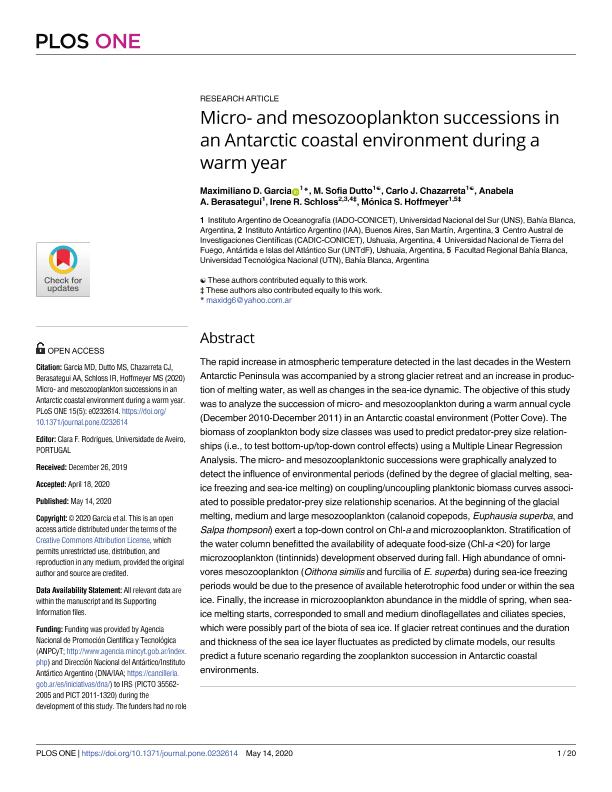Mostrar el registro sencillo del ítem
dc.contributor.author
Garcia, Maximiliano Darío

dc.contributor.author
Dutto, María Sofía

dc.contributor.author
Chazarreta, Carlo Javier

dc.contributor.author
Berasategui, Anabela Anhi

dc.contributor.author
Schloss, Irene Ruth

dc.contributor.author
Hoffmeyer, Monica Susana

dc.date.available
2021-09-10T16:34:05Z
dc.date.issued
2020-05-14
dc.identifier.citation
Garcia, Maximiliano Darío; Dutto, María Sofía; Chazarreta, Carlo Javier; Berasategui, Anabela Anhi; Schloss, Irene Ruth; et al.; Micro- and mesozooplankton successions in an Antarctic coastal environment during a warm year; Public Library of Science; Plos One; 15; 5; 14-5-2020; 1-20
dc.identifier.issn
1932-6203
dc.identifier.uri
http://hdl.handle.net/11336/140102
dc.description.abstract
The rapid increase in atmospheric temperature detected in the last decades in the Western Antarctic Peninsula was accompanied by a strong glacier retreat and an increase in production of melting water, as well as changes in the sea-ice dynamic. The objective of this study was to analyze the succession of micro- and mesozooplankton during a warm annual cycle (December 2010-December 2011) in an Antarctic coastal environment (Potter Cove). The biomass of zooplankton body size classes was used to predict predator-prey size relationships (i.e., to test bottom-up/top-down control effects) using a Multiple Linear Regression Analysis. The micro- and mesozooplanktonic successions were graphically analyzed to detect the influence of environmental periods (defined by the degree of glacial melting, sea-ice freezing and sea-ice melting) on coupling/uncoupling planktonic biomass curves associated to possible predator-prey size relationship scenarios. At the beginning of the glacial melting, medium and large mesozooplankton (calanoid copepods, Euphausia superba, and Salpa thompsoni) exert a top-down control on Chl-a and microzooplankton. Stratification of the water column benefitted the availability of adequate food-size (Chl-a <20) for large microzooplankton (tintinnids) development observed during fall. High abundance of omnivores mesozooplankton (Oithona similis and furcilia of E. superba) during sea-ice freezing periods would be due to the presence of available heterotrophic food under or within the sea ice. Finally, the increase in microzooplankton abundance in the middle of spring, when sea-ice melting starts, corresponded to small and medium dinoflagellates and ciliates species, which were possibly part of the biota of sea ice. If glacier retreat continues and the duration and thickness of the sea ice layer fluctuates as predicted by climate models, our results predict a future scenario regarding the zooplankton succession in Antarctic coastal environments.
dc.format
application/pdf
dc.language.iso
eng
dc.publisher
Public Library of Science

dc.rights
info:eu-repo/semantics/openAccess
dc.rights.uri
https://creativecommons.org/licenses/by/2.5/ar/
dc.subject
MICROZOOPLANKTON
dc.subject
MESOZOOPLANKTON
dc.subject
POTTER COVE
dc.subject
ANTARCTICA
dc.subject.classification
Oceanografía, Hidrología, Recursos Hídricos

dc.subject.classification
Ciencias de la Tierra y relacionadas con el Medio Ambiente

dc.subject.classification
CIENCIAS NATURALES Y EXACTAS

dc.title
Micro- and mesozooplankton successions in an Antarctic coastal environment during a warm year
dc.type
info:eu-repo/semantics/article
dc.type
info:ar-repo/semantics/artículo
dc.type
info:eu-repo/semantics/publishedVersion
dc.date.updated
2021-08-19T19:59:38Z
dc.journal.volume
15
dc.journal.number
5
dc.journal.pagination
1-20
dc.journal.pais
Estados Unidos

dc.journal.ciudad
San Francisco
dc.description.fil
Fil: Garcia, Maximiliano Darío. Consejo Nacional de Investigaciones Científicas y Técnicas. Centro Científico Tecnológico Conicet - Bahía Blanca. Instituto Argentino de Oceanografía. Universidad Nacional del Sur. Instituto Argentino de Oceanografía; Argentina
dc.description.fil
Fil: Dutto, María Sofía. Consejo Nacional de Investigaciones Científicas y Técnicas. Centro Científico Tecnológico Conicet - Bahía Blanca. Instituto Argentino de Oceanografía. Universidad Nacional del Sur. Instituto Argentino de Oceanografía; Argentina
dc.description.fil
Fil: Chazarreta, Carlo Javier. Consejo Nacional de Investigaciones Científicas y Técnicas. Centro Científico Tecnológico Conicet - Bahía Blanca. Instituto Argentino de Oceanografía. Universidad Nacional del Sur. Instituto Argentino de Oceanografía; Argentina
dc.description.fil
Fil: Berasategui, Anabela Anhi. Consejo Nacional de Investigaciones Científicas y Técnicas. Centro Científico Tecnológico Conicet - Bahía Blanca. Instituto Argentino de Oceanografía. Universidad Nacional del Sur. Instituto Argentino de Oceanografía; Argentina
dc.description.fil
Fil: Schloss, Irene Ruth. Consejo Nacional de Investigaciones Científicas y Técnicas. Centro Austral de Investigaciones Científicas; Argentina. Ministerio de Relaciones Exteriores y Culto. Dirección Nacional del Antártico. Instituto Antártico Argentino. Departamento de Biología Costera; Argentina. Universidad Nacional de Tierra del Fuego; Argentina
dc.description.fil
Fil: Hoffmeyer, Monica Susana. Ministerio de Relaciones Exteriores, Comercio Interno y Culto. Dirección Nacional del Antártico. Instituto Antártico Argentino; Argentina. Universidad Tecnológica Nacional. Facultad Regional Bahía Blanca; Argentina
dc.journal.title
Plos One

dc.relation.alternativeid
info:eu-repo/semantics/altIdentifier/url/https://journals.plos.org/plosone/article?id=10.1371/journal.pone.0232614
dc.relation.alternativeid
info:eu-repo/semantics/altIdentifier/doi/https://doi.org/10.1371/journal.pone.0232614
Archivos asociados
